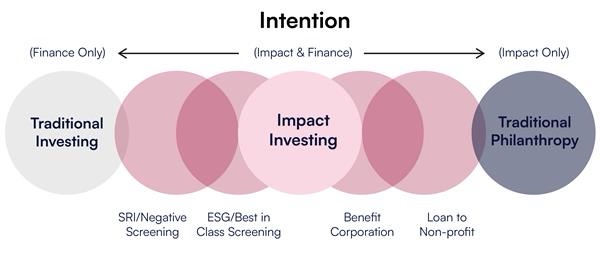Impact investing is experiencing significant growth, particularly in Asia, where both institutional and individual investors are becoming increasingly active spurred by government support, which is playing a key role in fostering the development of the market.
Asia is deemed as the emerging impact investing giant, with heavy investments being made across sectors such as renewable energy, affordable housing and microfinance. There is a rising interest from both local and international investors in Asia aiming to achieve positive social and environmental outcomes alongside financial returns.
According to a recent report by GIIN, 68 Asia-focused investors managing over USD 38 billion in impact assets under management (AUM) found that 89% of them saw financial returns meeting or exceeding expectations. This underscores the accelerating momentum of the impact investing market, which is poised to grow even further in 2025.
What Is Impact Investing ?
Impact investing refers to investments that aim to make a measurable social or environmental impact in addition to making a financial profit. Impact investing is, hence, different from traditional investments that are purely focused on financial returns. This method is being adopted more frequently around the world as economic growth and sustainability become more interconnected.
Investing can be classified as a spectrum ranging from pure philanthropy to traditional profit-driven investing. Impact investing occupies that middle ground, striving for financial profit as well as social and ecological returns.
Philanthropy does not require any financial return in exchange for social good. While Responsible investing, such as negative screening practices, focus on attaining profit while paying attention to metrics such as ESG performance and ratings. . On the other hand, traditional investing is done with a limited ESG focus. ESG aspects are considered only when they have a bearing on risk/return.
Impact investing covers areas, such as renewable energy, education, healthcare, sustainable agriculture, and affordable housing. It addresses a few of the most pressing issues in the world today, such as climate change, social inequality, and poverty, through investments that provide measurable and additional results.
Impact investors span across profiles and may include private investors, private equity firms, foundations, or government agencies.
Read more: ESG Risk Ratings vs ESG Impact Ratings
Types of Impact Investing
1) Green Investments: These investments target renewable energy, energy efficiency, and carbon-neutral technologies. The primary goal is to reduce greenhouse gas (GHG) emissions. Asia is now a substantial investor in solar, wind, and hydroelectric projects, as the region has become one of the largest emitters of GHG.
2) Social Impact Investments: These investment strategies address critical social issues such as education, healthcare, and gendered impacts. In Asia, the recent focus has been on microfinance projects and affordable healthcare programs. By leveraging SDG impact ratings, investors can better assess how these initiatives contribute to the United Nations’ Sustainable Development Goals (SDGs), ensuring their capital drives measurable, positive change in areas like quality education (SDG 4), good health and well-being (SDG 3), and gender equality (SDG 5).
3) Nature and Biodiversity Investments: Investments in this category aim at avenues such as natural ecosystem conservation, sustainable agriculture development, and biodiversity. Southeast Asia is a hotspot for international biodiversity investments because of its extensive resources. Due to the increasing global attention on deforestation, and ecosystem degradation and the risks emanating from them, nature and biodiversity investments are now crucial for investors. Governments and organizations are starting to implement stricter sustainability regulations alongside incentives for green investments.
4) Transition Investing: This investment method supports businesses and industries across their shift from traditional processes to sustainable methods. Transition investing focuses on the funding of companies, projects, or technologies which are shifting from a high-carbon, unsustainable business model to a low-carbon, sustainable one. It acknowledges that a lot of industries, especially some of the highest emitters, such as energy, transport, and manufacturing, have a longer timeframe for decarbonizing. This type of investing also recognizes that there is a need for supporting capital to help these industries achieve a structured, long-term transition.
5) Gender-lens Investing: Gender-lens investing focuses on investment in women’s entrepreneurship and businesses promoting women’s rights and opportunities. This form of investment addresses some of the structural discrimination that exists and helps develop the economy in a more balanced format, particularly in education and healthcare. Some interesting examples include:
- Public Market Funds: Gender-diversity ETFs: SPDR SSGA Gender Diversity Index ETF, commonly referred to as SHE, is an exchange-traded fund that invests in public companies with extensive gender equity in their leadership roles.
- Private Equity & Venture Capital: Gender-lens Funds: Beyond the Billion (BTB) is a consortium of venture capital funds that invest in women entrepreneurship-led businesses.
Understanding Asia’s Impact Investing Market
Asia is steadily emerging in the impact investing landscape. The region’s economic expansion, alongside pressing social and environmental issues, is fueling the demand for sustainable investing. For example, India, China, and Indonesia, are investing heavily in renewable energy, affordable housing, and microfinance projects.
• Renewable Energy: China dominates the global scale in electric clean energy investments by placing over $546 billion in 2022, which is approximately 50% of the total investment. India is a leading producer of both solar and wind electricity and intends to achieve 500 GW of non-fossil fuel electricity capacity by 2030. Indonesia also reclines in the list of renewable project investors and aims to produce 23% of its energy from renewable sources by 2025.
• Affordable Housing: The affordable housing industry in Asia is expected to grow to $1.3 trillion by 2030 to accommodate the rising urban population. India, one of the many countries that are beating this challenge, has pledged to build 20 million affordable apartments under its ‘housing for all’ project.
• Microfinance and Financial Inclusion: Since Asia is home to over 60% of the world’s unbanked individuals, microfinance has become a necessity4. The rise of microfinance institutions across the globe has helped small businesses in countries like Bangladesh, India, and Indonesia gain access to capital.
Key Impact Investing Trends Shaping the Asian market
1) Impact Investing Powered by AI and Technology
The development of artificial intelligence (AI) and machine learning (ML) technologies has significantly impacted the impact investing field through advanced data analysis and forecasting. Blockchain and other technologies make impact investing more robust by promoting tracking and accountability. In Asia, technology is being incorporated into agriculture, healthcare, and renewable energy. It fosters resource-efficient practices and provides timely project performance updates with assurance to the investors about their positive impact decisions.
2) Nature and Biodiversity Investments
There is a surge of investment in reforestation, mariculture, and sustainable agriculture as the world becomes more concerned about preserving biodiversity. Countries in Southeast Asia that possess some of the world’s richest biodiversity hotspots are receiving funding to mitigate deforestation and promote eco-tourism.
For instance, reforestation projects in Indonesia and Malaysia are gaining traction from private-public partnerships. Such investments are bound to help economic growth among the local population while enhancing environmental protection.
3) Transition Investing
Transition investing enables sectors such as manufacturing and energy to adopt greener technologies. For example, there is a gradual decline in the region’s coal dependence and an increase in investments in solar and wind energy infrastructure. This pattern is also seen in manufacturing as industries are switching to energy-efficient machines and embracing circular economy practices to reduce waste.
In Asia, this shift is primarily driven by policies, climate commitments, and rising investor interest in green technologies. Traditionally, coal-focused industries are now adopting wind and solar energy, which makes investing in the transition necessary. Transition investments are also imperative in the circular economy, where production and waste integration are used to make eco-friendly machinery that minimizes waste and carbon emissions. By funding this change, climate risks are mitigated while tapping into deeper economic opportunities, making transition investing a strategic priority for investors and businesses in Asia.
4) Collaborative Platforms and Policies
Investments are growing across socio-economic spheres through collaboration between the government, NGOs, and private organizations. Policies facilitating public-private collaborations and subsidizing green investments have greatly benefited the sector.
In Singapore and South Korea, government platforms are established to match investors with projects that are deemed impactful. Such partnerships provide the basis for the creation of new standards, which ease the process of evaluating and investing in projects globally.
5) Regional Cooperation
The ASEAN Green Finance Framework and other initiatives promote cooperation among countries in the Asian region, contributing to the growth of impact investing in the region.
Read more: Impact of AI on ESG Assessment: What Asset Managers Need to Know
The Roadblocks and the Rewards: Navigating Impact Investing
The Challenges of Scaling Impact Investing
Impact Assessment: The measurement of social and environmental returns from investments is still a major challenge. Unlike financial returns, tangible results from initiatives in biodiversity or education sectors require complex systems and prolonged monitoring.
For instance, assessing the changes in species populations as a measure of improvement in biodiversity is difficult and resource heavy. Likewise, assessing educational changes may require long-term data on performance and the resources available to them.
- Regulatory Limitations: Differences in regulations for different countries in Asia present a complicated issue for cross-border investment and partnerships. Differences in what impact investing is and the compliance criteria for the same, affect investors greatly.
- Access to Capital: Funding is often a challenge with innovative small-scale projects and new startup businesses that have the potential to solve environmental and social problems. A general perception among investors is that such ventures have low scalability and poor records, which makes them too risky. This problem becomes more intense in developing areas where the financial infrastructure is weak.
- Impact-washing: An area of concern is that impact-washing, or false claims made regarding the sustainability of investments, is prevalent and results in reduced trust in the market. While emerging anti-greenwashing regulations have aimed to mitigate for this, such actions have resulted in growing distrust among investors.

Driving Change Through Impact Investing Opportunities
Technological Advancements: Emerging technologies such as AI, blockchain, and IoT are changing the landscape of impact investments. By facilitating a vast addressable market for investment, AI makes it easier to analyze the data and accurately assess the ESG impact ratings of the investment.
Moreover, blockchain tracks the result of the investment, which promotes transparency and accountability. IoT sensors in agriculture can gather data on water levels, nutrient levels, and even track the health of the crops, helping investors make informed decisions.
- Policy Support: Several countries in Asia are coming up with plans and attempts to promote and support impact investments. The introduction of tax benefits, green financing grants, and regulatory frameworks for providing aid is expanding the porosity of the sector. For instance, India and China have kicked off green bond programs, enabling a more orderly approach toward investment that supports sustainability.
- Scaling Solutions: The collaboration between the private sector and government is an effective method for expanding impactful projects. Public-private collaborations allow sharing of resources and are more feasible for large-scale projects. This is most needed in developing countries where infrastructure and capital are inadequate. For example, the collaboration of government and private sectors in renewable energy has been able to electrify isolated regions.
Read more: Regulatory Scenario for ESG Rating Providers
Conclusion
Impact investing has evolved into a significant industry from its original focus area. Developments such as AI adoption, biodiversity conservation, and transition investing capture the growing attention of the Asia Pacific region. Despite challenges like inconsistent regulations and greenwashing, the opportunities far outweigh the challenges posed.
The improvement in technology, enhanced collaboration, and focus on measurable results allow for the complete harnessing of the energy of impact ratings as a measurement tool. As social and environmental goals are increasingly supported by finance-based approaches, impact investing will certainly play a significant role in the global shift toward a sustainable future in 2025.



